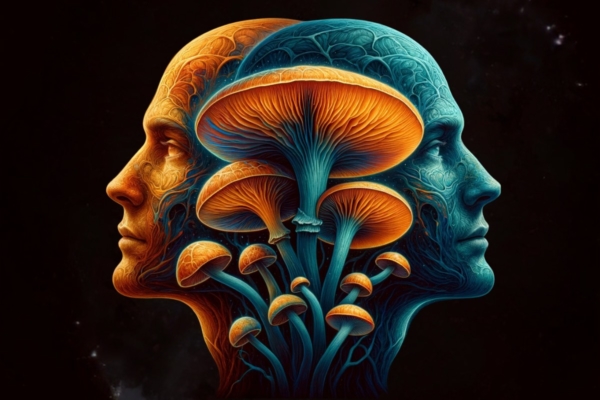
Many people have deep, spiritual experiences through the use of psychedelics. Others may touch the ineffable through religious ceremonies or holy communions. However, more and more people are testifying that these states may be reached simply through changing the way that you breathe. Here is our Beginner’s Guide to Breathwork.
“I had to somatically experience breathwork to believe it. And so it was that an introverted English woman lay on the floor with a bunch of strangers and sobbed. I was more grounded and more free in that moment than I have ever been.”
– Vanessa Potter, Finding My Right Mind
What is Breathwork?
Breathwork is an umbrella term for a huge range of practices. Broadly, it’s defined as intentionally controlling the depth or speed of breathing for physical or psychological purposes. However, there are many forms and traditions that breathwork encompasses.
The origins of modern breathwork practised in the West may be traced back to Pranayama. Prana, meaning ‘life source’, and yama meaning ‘control’ or ‘restraint’. These practices involve the voluntary control of the breath, in a formal sequence, and are common within different yogic traditions. While Pranayama has a long and complex history, there are several contemporary traditions of breathwork that may have stemmed from these practices.
Wim Hof Method
Known colloquially as ‘The Iceman’, Wim Hof is a Dutch extreme athlete who holds 21 world records, including one for running a half marathon above the Arctic circle, with no shirt or shoes on. Hof doesn’t claim to be a freak of nature —he has pioneered a method that can ostensibly allow anyone to achieve such feats.
The Wim Hof method includes three elements: cold exposure, concentration meditation, and breathing exercises. The breathing exercises involve very deep inhalations and exhalations, followed by periods of breath retention. The purpose of this method firmly falls under the physical category —Hof claims that his method can help treat a range of inflammatory illnesses.
Holotropic Breathwork
Stanislav Grof, psychiatrist and pioneer of the psychedelic revolution of the ‘50’s and ‘60’s, developed an alternative healing modality with his wife, Christina. This method, dubbed Holotropic Breathwork, was created as a reaction to the blanket ban on psychedelic substances in 1971. Grof and his wife found that patients could enter a powerful altered state of consciousness simply through breathing in a rhythmic and controlled fashion (with no space between the in- and out-breath).
Much like psychedelic therapy, Holotropic Breathwork emphasises the necessity of a good set and setting. Participants will wear an eye mask to ‘go inward,’ and will listen to a curated playlist of evocative music. Integration also forms a large part of the process, where participants draw and discuss their experiences during the intense breathwork sessions.
Breathwork — A Psychedelic Overlap?
It’s fascinating that Grof, a psychedelic practitioner who administered LSD to thousands of patients, thought that a breathwork experience could be just as revealing as a psychedelic session. So, how similar are these practices to psychedelics?
Well, a study conducted in 2014 looked at the subjective effects of 134 participants who underwent a single holotropic breathwork session. According to the study, around 10% of the participants met criteria for a “complete” mystical experience. The mystical experience includes feeling a deeply positive mood, transcending time and space, and feeling a communion with the universe.
Interestingly, the mystical experience is also a hallmark of the psychedelic state. This percentage of people having a “complete” mystical experience, that is, scoring highly on all aspects of the questionnaire, is comparable to a medium dose of the psychedelic, psilocybin.
However, more research is needed to uncover how similar psychedelics and breathwork really are on a larger scale. A breathwork session is deeply personal; while there may be individuals who experiences a sense of oneness with the universe, there may be others that do not feel much at all.
The Autoimmune Effects of Breathwork
One of the most notable studies into breathwork was conducted on Wim Hof himself. Hof has claimed that his method can inhibit the autoimmune response. To test this, scientists from Radboud University in the Netherlands injected Hof with an endotoxin. Within a normal and healthy participant, this endotoxin would produce an uncontrollable immune response, like nausea, and a severe headache.
However, through the practice of his method, Hof managed to suppress this immune response through the voluntary control of the autonomic nervous system. According to modern science, this capacity was previously thought to be beyond human capabilities.
To go even further, Hof claims he is not superhuman —he simply uses his breathing method to incur these phenomenal effects. The scientists then took 12 new healthy volunteers that underwent Hof’s training program for 10 days, consisting of breathing exercises, cold exposure, and concentration meditation. Again, these healthy volunteers were injected with an endotoxin, and compared to 12 control volunteers who had not practised the Wim Hof method. Remarkably, the volunteers trained in the method experienced significantly less flu-like symptoms, whilst having significantly higher levels of anti-inflammatory proteins within their blood.
While this study has incredibly important implications for how inflammatory illnesses are treated in the future, we may not be sure how effective breathwork is at treating psychotherapeutic issues. Grof swears that his method is a suitable way to explore the depths of the unconscious, but to back this up we need large-scale clinical trials. Hopefully with the advent of psychedelic interest, there will also come scientific interest into the potential of breathwork as a healing modality.





